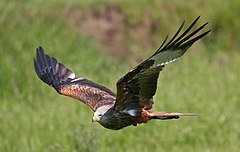Milvus
| Milvus[1] | |||
| Lacépède, 1799[2] | |||
 Przedstawiciel rodzaju – kania ruda (M. milvus) | |||
| Systematyka | |||
| Domena | |||
|---|---|---|---|
| Królestwo | |||
| Typ | |||
| Podtyp | |||
| Gromada | |||
| Podgromada | |||
| Infragromada | |||
| Rząd | |||
| Rodzina | |||
| Podrodzina | |||
| Plemię | |||
| Rodzaj |
Milvus | ||
| Typ nomenklatoryczny | |||
|
Falco milvus Linnaeus, 1758 | |||
| Synonimy | |||
|
| |||
| Gatunki | |||
| |||
Milvus – rodzaj ptaków z podrodziny jastrzębi (Accipitrinae) w rodzinie jastrzębiowatych (Accipitridae).
Zasięg występowania[edytuj | edytuj kod]
Rodzaj obejmuje gatunki występujące w Eurazji, Afryce i Australazji[5].
Morfologia[edytuj | edytuj kod]
Długość ciała 44–72 cm, rozpiętość skrzydeł 120–171 cm; masa ciała samic 750–1600 g, samców 630–1221 g[5].
Systematyka[edytuj | edytuj kod]
Etymologia[edytuj | edytuj kod]
- Milvus: łac. milvus „kania”[6].
- Ictinus: gr. ικτιν iktin lub ικτινος iktinos „kania”[7]. Gatunek typowy: Falco milvus Linnaeus, 1758.
- Hydroictinia: gr. ὑδρο- hudro- „wodny-”, od ὑδωρ hudōr, ὑδατος hudatos „woda”; rodzaj Ictinia Vieillot, 1816 (kanialuk)[8]. Gatunek typowy: Falco migrans Boddaert, 1783.
Podział systematyczny[edytuj | edytuj kod]
Do rodzaju należą następujące gatunki[9]:
- Milvus milvus (Linnaeus, 1758) – kania ruda
- Milvus migrans (Boddaert, 1783) – kania czarna
Przypisy[edytuj | edytuj kod]
- ↑ Milvus, [w:] Integrated Taxonomic Information System (ang.).
- ↑ B.G. de Lacépède: Discours d’ouverture et de clôture du cours d’histoire naturelle, donné dans le Muséum national d’Histoire naturelle, l’an VII de la République, et tableaux méthodiques des mammifères et des oiseaux. Paris: Plassan, 1799, s. 4. (fr.).
- ↑ F.O. Morris. A new system of nomenclature, illustrated by a list of British birds. „The Naturalist”. 2 (9), s. 123, 1837. (ang.).
- ↑ J.J. Kaup: Classification der Säugethiere und Vögel. Darmstadt: C. W. Leske, 1844, s. 115. (niem.).
- ↑ a b D.W. Winkler, S.M. Billerman & I.J. Lovette: Hawks, Eagles, and Kites (Accipitridae), version 1.0.. W: S.M. Billerman, B.K. Keeney, P.G. Rodewald & T.S. Schulenberg (red.): Birds of the World. Ithaca, NY: Cornell Lab of Ornithology, 2020. DOI: 10.2173/bow.accipi1.01. [dostęp 2020-06-05]. (ang.).

- ↑ Milvus, [w:] The Key to Scientific Names, J.A. Jobling (red.), [w:] Birds of the World, S.M. Billerman et al. (red.), Cornell Lab of Ornithology, Ithaca [dostęp 2022-01-03] (ang.).
- ↑ Ictinus, [w:] The Key to Scientific Names, J.A. Jobling (red.), [w:] Birds of the World, S.M. Billerman et al. (red.), Cornell Lab of Ornithology, Ithaca [dostęp 2022-01-03] (ang.).
- ↑ Hydroictinia, [w:] The Key to Scientific Names, J.A. Jobling (red.), [w:] Birds of the World, S.M. Billerman et al. (red.), Cornell Lab of Ornithology, Ithaca [dostęp 2022-01-03] (ang.).
- ↑ Systematyka i nazwy polskie za: P. Mielczarek & M. Kuziemko: Plemię: Accipitrini Vigors, 1824 (Wersja: 2019-03-24). [w:] Kompletna lista ptaków świata [on-line]. Instytut Nauk o Środowisku Uniwersytetu Jagiellońskiego. [dostęp 2020-06-05].
Identyfikatory zewnętrzne:
